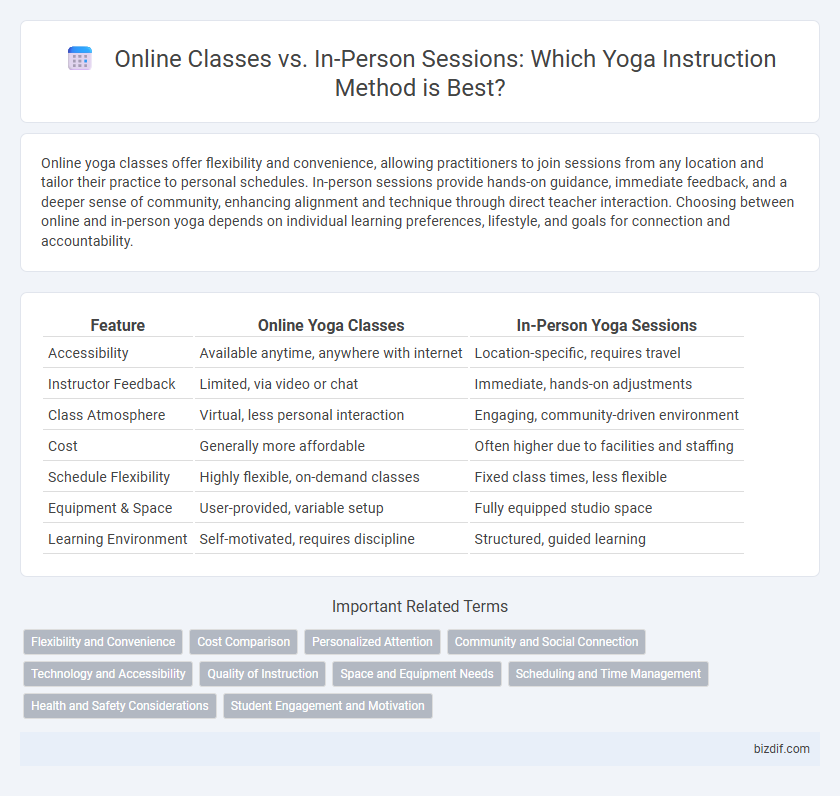Online yoga classes offer flexibility and convenience, allowing practitioners to join sessions from any location and tailor their practice to personal schedules. In-person sessions provide hands-on guidance, immediate feedback, and a deeper sense of community, enhancing alignment and technique through direct teacher interaction. Choosing between online and in-person yoga depends on individual learning preferences, lifestyle, and goals for connection and accountability.
Table of Comparison
| Feature | Online Yoga Classes | In-Person Yoga Sessions |
|---|---|---|
| Accessibility | Available anytime, anywhere with internet | Location-specific, requires travel |
| Instructor Feedback | Limited, via video or chat | Immediate, hands-on adjustments |
| Class Atmosphere | Virtual, less personal interaction | Engaging, community-driven environment |
| Cost | Generally more affordable | Often higher due to facilities and staffing |
| Schedule Flexibility | Highly flexible, on-demand classes | Fixed class times, less flexible |
| Equipment & Space | User-provided, variable setup | Fully equipped studio space |
| Learning Environment | Self-motivated, requires discipline | Structured, guided learning |
Flexibility and Convenience
Online yoga classes offer unparalleled flexibility, allowing practitioners to tailor sessions around their personal schedules and practice from any location. In-person sessions provide a structured environment with immediate instructor feedback and a community atmosphere that can enhance motivation and technique. Both formats cater to different needs, balancing convenience with hands-on guidance for an optimal yoga experience.
Cost Comparison
Online yoga classes typically offer more affordable rates compared to in-person sessions, with monthly subscriptions ranging from $10 to $50, whereas studio classes often charge $15 to $30 per individual session. The reduced overhead for virtual instructors enables lower pricing without compromising instructional quality, making online options budget-friendly for consistent practice. In-person sessions may include additional costs such as travel, parking, and equipment rentals, which increase the total expense relative to virtual participation.
Personalized Attention
Online yoga classes offer flexible scheduling but may limit personalized attention due to screen constraints, affecting the instructor's ability to correct posture and provide real-time adjustments. In-person yoga sessions enable direct observation and tailored feedback, enhancing alignment and technique improvement through hands-on guidance. Personalized attention in face-to-face classes leads to more effective practice outcomes and reduced risk of injury.
Community and Social Connection
Online yoga classes offer flexibility and accessibility, allowing practitioners to join from anywhere while fostering a digital community through interactive platforms. In-person sessions enhance social connection by providing real-time group energy, hands-on adjustments, and face-to-face interactions that deepen relationships. Both formats support community building, but physical presence in studios cultivates a stronger sense of belonging and collective motivation.
Technology and Accessibility
Online yoga classes leverage advanced streaming platforms and mobile apps to provide flexible access to diverse instructors and styles worldwide. High-speed internet and user-friendly interfaces enable seamless participation from home, overcoming geographical and mobility barriers. In-person sessions offer tactile feedback and real-time adjustments but are limited by location and scheduling constraints compared to the technological scalability of online formats.
Quality of Instruction
Online yoga classes provide flexible access to diverse instructors and styles worldwide, enhancing personalized learning opportunities. In-person sessions offer direct physical adjustments and immediate feedback, fostering deeper alignment and posture correction. The quality of instruction depends on factors such as instructor expertise, student engagement, and adaptability to individual needs across both formats.
Space and Equipment Needs
Online yoga classes require minimal physical space and often only need basic equipment like a yoga mat and comfortable clothing, making them accessible in small living areas. In-person sessions typically demand a dedicated studio space equipped with props such as blocks, straps, bolsters, and sometimes specialized flooring to enhance safety and comfort. The controlled environment of a studio also supports better instructor adjustments and student alignment, which can be challenging to achieve in online formats due to limited space and equipment variations.
Scheduling and Time Management
Online yoga classes offer flexible scheduling options, allowing practitioners to join sessions from any location and at varied times, accommodating busy lifestyles. In-person sessions typically follow fixed schedules, requiring travel time and stricter adherence to class timings, which can impact overall time management. Choosing online classes enhances the ability to integrate yoga into daily routines with minimal disruption, benefiting those with unpredictable or tight schedules.
Health and Safety Considerations
Online yoga classes minimize exposure to germs and viruses, making them a safer option during health crises like the COVID-19 pandemic. In-person sessions require strict adherence to hygiene protocols, such as sanitized mats and social distancing, to reduce the risk of infection. Choosing between online and in-person yoga depends on personal health concerns and comfort with physical attendance in group settings.
Student Engagement and Motivation
Online yoga classes offer flexible scheduling and access to a diverse range of instructors, enhancing student motivation through convenience and variety. In-person sessions foster deeper engagement by providing hands-on adjustments and real-time community interaction, which can boost accountability and focus. Combining both methods can optimize student commitment by leveraging the strengths of digital accessibility and physical presence.
Online classes vs In-person sessions Infographic

 bizdif.com
bizdif.com